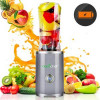Pyle NCBL100RC Instruction Manual - Page 6
Super Heated Water
 |
View all Pyle NCBL100RC manuals
Add to My Manuals
Save this manual to your list of manuals |
Page 6 highlights
1. To prevent possible injury, always use protective oven gloves and direct steam away from hands and face. 2. Follow the precautions and recommendations found in your microwave oven instruction manuals, speci cally the overall heating times, but never run microwave longer than 2 minutes consecutively. Heat for 2 minutes. Let the food sit for 2 minutes, remove from microwave, open the container and carefully stir, then heat for 2 minutes again. 3. Do not use excessive amounts of time when heating water or liquids in the microwave, and do not exceed more than 2 minutes consecutively. 4. Do not overheat the liquid. 5. Super Heated Water - Liquids such as water, co ee, tea or soups are able to be overheated beyond the boiling point without appearing to be boiling. Visible bubbling or boiling when the container is removed from the microwave is not always present. This could result in very hot liquids suddenly boiling over when the container is disturbed or a spoon or other utensil is inserted into the liquid. To reduce the risk of injury to persons. 6. Stir the liquid both before and halfway through heating it to avoid eruption. 7. Use extreme care when inserting a spoon or other utensils into the container. 8. Avoid heating baby food or formula in cups. 9. Don't defrost frozen beverages in cups (especially carbonated beverages). Even if the container is opened, pressure can build up. This can cause the container to burst, possibly resulting in injury. 10. Hot foods and steam can cause burns. Be careful when removing cups from the microwave when they contain hot foods and liquids. 11. Do not overcook food. Carefully attend to appliance when Cups are placed inside an operating microwave. 12. After heating, allow the container to stand in the microwave for a short time before removing container. 13. After microwaving, always use heat resistant pads to handle cups. Allow the ingredients to settle for a moment and then carefully open the lid pointing the container away from your body as escaping steam and moisture may cause scalding burns. 6 www.NutriChefKitchen.com















